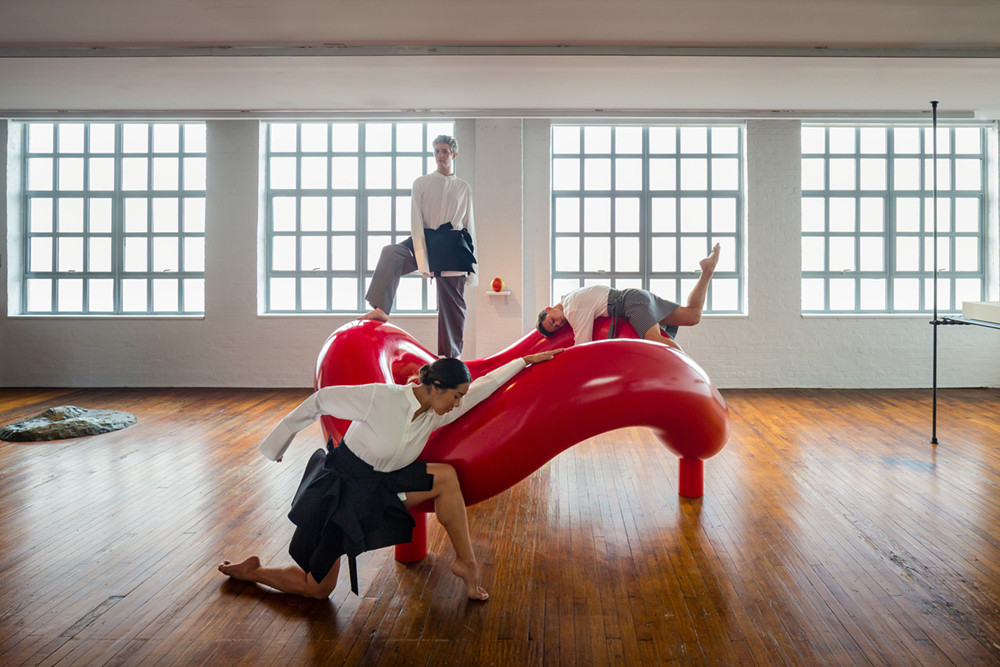[ad_1]
Over the past year or so, Brendan Fernandes, who trained as a ballet dancer before turning to visual art, has been making work that explicitly foregrounds dance’s reliance on mastery, skill, and self-control. His contribution to the 2019 Whitney Biennial, a performance-based installation titled The Master and Form, featured—like many of his pieces—an elaborate sculptural scaffolding and thick ropes that dancers used as aids in stretching and contorting their bodies. In his performance Ballet Kink, staged at the Guggenheim Museum in New York this past May, the art of Japanese rope bondage, or shibari, was a central motif. While his self-styled “ballet kink” nods to sexual subcultures like BDSM and the gay male leather community, Fernandes insinuates that discipline, dominance, and submission have always been part and parcel of dance.
Photo Nicholas Knight. ©The Isamu Noguchi Foundation and Garden Museum, NY / ARS.
There’s little obvious kink in Fernandes’s new performance-based work, Contract and Release at the Noguchi Museum. There are, however, what he calls “training devices”—six chairs he fabricated to resemble the rocking-chair-style one that Isamu Noguchi designed for Martha Graham’s iconic 1944 ballet, Appalachian Spring. Contract and Release takes place within “Body-Space Devices,” a two-gallery exhibition of sculptures from the museum’s permanent collection that illustrate Noguchi’s interest in creating works that engage the body. Fernandes has augmented this display with a series of shelving units that hold additional Noguchi objects and props handled by dancers during the roughly hour-long performance, which happens twice on Saturdays during the run of the show.
Photo Nicholas Knight. ©The Isamu Noguchi Foundation and Garden Museum, NY / ARS.
For the most part, the Noguchi sculptures in these rooms allude to the body obliquely or suggest physical activity only metaphorically. Consisting of slender, interlocking forms, the vaguely anthropomorphic Figure (1945, cast 1986) and Fishface (1945, cast 1989) look as if they could be assembled and disassembled, but they’re made of solid bronze. With the help of the museum’s collections coordinator, Danny Da Silva (also a woodworker), Fernandes has re-created several of the works as wood maquettes that can in fact be taken apart and reconstructed—one of the “tasks” that the performers are instructed to execute.
Aside from the prescribed tasks, many of which stipulate hitting specific Graham poses, Fernandes’s choreography is improvised while remaining within the lexicon of the Graham technique, in which every movement follows from breathing, from contracting and releasing in the abdominal core. Most of the slowly shifting poses in Fernandes’s performance—arms stretching high with spread feet, for instance—occur on the aforementioned custom chairs. Although the original Noguchi chair echoed a rocking chair’s design, it was stationary. Fernandes’s versions are not. Their rocking back and forth makes the movements even harder to carry out, rendering the activity a grueling exercise in self-control.
Photo Nicholas Knight. ©The Isamu Noguchi Foundation and Garden Museum, NY / ARS.
Most striking about Contract and Release is how sculptural the performers look. With the performance taking place around real sculptures in the museum’s galleries, body and artwork become literally adjacent, heightening the play between the two. At one point, near the end of the piece, the dancers climb atop Noguchi’s Play Sculpture (ca. 1965, fabricated 2017), a wavy red circular structure on legs. The work is the only one in the museum that visitors are allowed to interact with physically. Fernandes’s performers stand on the object, stretching their arms to the ceiling, or bend over it backward, grazing the floor with their fingers. Such movements make real Noguchi’s wish for his work to be more than static sculpture, to be something that could have a kind of life.
This article appears under the title “Brendan Fernandes” in the December 2019 issue, pp. 98–99.
[ad_2]
Source link


